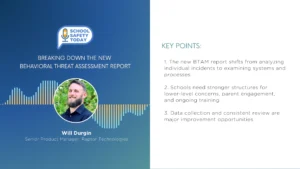How Technology and Data Can Improve Standardized Testing
We’ve begun a new school year with continued challenges for students, teachers, parents, and other learning guardians. Having spent the spring semester navigating the new world of widespread distance learning, we all hoped the 2020-21 school year could have started in person. Students across the country received a different education experience at home this past spring. In prioritizing student and community health, we’ve accepted there will continue to be variation in students’ learning environments for now—and this calls for a new look at assessments.
Related content: 10 ways assessment reform can lead to a new era in education
While the National Assessment Governing Board decided to proceed with scheduled 2021 testing, most educators have no standardized testing data available from the 2019-20 school year. Research shows that students could be returning to school this fall with half of the expected learning gains in math. Without data from the usual classroom-based and state assessments last spring, one big question on everyone’s mind is how to approach this school year while addressing learner needs.
Standardized assessments won’t make the grade
Standardized tests administered early in the year are a typical tool used by schools. Yet this pandemic has shined an even brighter light on the shortcomings of standardized assessments, as both Lorrie Shepard and Dylan Wiliam have recently written about.
While these tests can provide some information about where students are in their learning, they also have unintended consequences. For example, standardized testing often takes away instructional time and puts pressure on teachers who need enough time to deliver the intended curriculum.
According to research conducted by the University of Washington, standardized assessments also cause teachers to focus their energy away from quality lesson and instructional planning and more toward test preparation.
Students also feel pressure, in only one time-bound exam, to demonstrate comprehension for seemingly every concept. Because students can face overwhelming amounts of stress – especially those disproportionately impacted by the pandemic – it can lower their performance and prevent teachers from getting accurate information. While meaningful data about students’ prior knowledge is always crucial to making plans for differentiation and personalization, students are currently coping with elevated stress from changes in their learning environment, disconnect from peers and teachers, and pandemic health concerns for their families and loved ones. Students don’t need any more pressure, and time spent testing could instead be used to address students’ social emotional and other learning needs.
Rather than find ways to “return to normal” and fall back into the habit of standardized testing, education leaders have an opportunity to find and create simple, effective ways to evaluate students’ learning growth and gather meaningful insights about each learner. Tom Vander Ark recently described several ways to use “Smart Measurement Rather Than Dumb Assessments” as he built on the work of David Conley around Next Generation Assessments. Some of the key questions we need to answer are: What if we focused on meeting each student where they are rather than teaching to a test? What if there is a better way to collect learning growth data in real-time that doesn’t take time away from learning? What if instead of assessing subject understanding with a single, short test, learning assessment was continuous, enabling teachers to intervene early and often?
Educational technology can deliver data now
Educators have new answers to these questions using innovative technologies that complement their virtual or in-person instruction with real-time data and actionable insights. Teachers can leverage these valuable data to make sure every moment with students is impactful all school year long – whether they are in the classroom or at home.
With intelligent adaptive learning technology, embedded assessments are already able to develop detailed formative and summative reports on student learning progress. Some programs can also provide educators with predictive insights into each student’s learning growth relative to how the student would perform on a spring test of their state’s grade level standards.
Technology tools can also help teachers connect with students in remote learning, track student attendance, and assess whether a student is struggling or excelling in a concept; all without standardized tests or requiring an extended amount of screen time.
In the best cases, learning insights go far beyond standardized, multiple choice test results because technologies can evaluate not only students’ right and wrong answers, but also understand how students solved problems. When we are able to see what strategies students use as they think critically and problem solve, we have much richer insights into how deeply they understand concepts. This depth of insight helps personalize the learning experience for students by adapting based both on students’ answers as well as how they “show their work.” This continuous personalization also enables teachers to know how and when to intervene year-round and can be shared with parents and guardians at home. Whether they are learning concepts that are below, at, or above grade level, students can have their unique needs addressed without stopping to take a test that interrupts their learning experience.
Making every moment a teaching moment
Information about student learning is more important than ever – and we need new approaches instead of relying heavily on standardized tests. By complementing teacher lessons and providing the insights educators need at the right time, new assessment tools and technologies can reduce the over-emphasis on testing as the primary way to generate data. If we can rethink student assessment and use new tools to solve the issues facing teachers and students, we can make every moment count.








